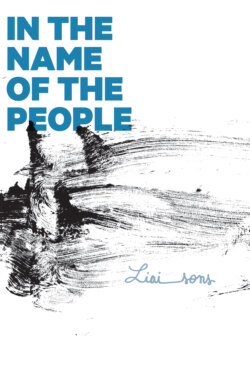Читать книгу In the Name of the People - Liaisons - Страница 21
На сайте Литреса книга снята с продажи.
THE PEOPLE’S ANTIFASCIST UPRISING
ОглавлениеDifferent tactics were used to give the occupation of Crimea and Donbass the appearance of popular movements. In Crimea, where Russia has large military bases, it was easy to fill the peninsula with soldiers in a few days. These forces rapidly took over the most important infrastructural points, such as the parliament and the airport, after which they adopted an “observer” role to appear as a “peacekeeping” force to ensure that the “people’s uprising” went smoothly, and that Russian-speaking populations were not “attacked.”
In a disconcerting game of mirrors, pro-Russian forces started to copy the tactics used at Maidan. In the first days of the annexation, the “self-defense forces” of Crimea were created, copying the self-defense forces of Maidan. Officially, they were created by locals who wanted to defend their cities from the Nazi hordes allegedly arriving from Kiev. Of course, it was quickly shown that these self-defense militias were controlled by Russian officers. They were composed of Cossacks, local petty criminals, pro-Russian right-wingers, and red-brown activists from Russia. In reality, the self-defense groups and the Russian military operated together. During the assaults, plainclothes self-defense officers were performing all the actions, to portray for the media an image of the people’s revolt. The soldiers were never far away, ready to step in if the Ukrainian security services or army intervened. This tactic contributed to creating the simulacrum of a peaceful and voluntary annexation.
The foundations of this communications strategy were laid during Maidan, while the Anti-Maidan movement grew in the eastern cities of Ukraine. At the core of this movement were pro-Russian groups, already familiar with Russian-imperial ideas. Anti-Maidan named itself an antifascist movement and repeated Russian propaganda’s main clichés. Anti-Maidan’s discourse was the inverse of Maidan: there were calls to join Russia, reinstall Yanukovych to power, celebrate the Berkut, and invite Russian troops to occupy the country. At the same time, there were also several ordinary people participating in Anti-Maidan—people who genuinely believed that a motley coalition of Nazis, homosexuals, and the American “deep state” had joined forces and seized power in Kiev.
At the beginning, Anti-Maidan presented itself as another movement against Maidan. One street demonstration against another street demonstration, occupations of state buildings against other occupations, one constitutive violence against another. On the ground, however, the realities of the two movements could not be further apart. In Donetsk and Luhansk, the Anti-Maidan movement acted with the support of local bureaucrats, the police, and organized crime. While Maidan was repressed, Anti-Maidan had free reign, and it helped the pro-Russians gain a significant number of official buildings and arms. “People’s Assemblies,” controlled by armed activists, elected “popular representatives.” “People’s Republics” were proclaimed, calling on Russian troops and holding referendums about joining the Russian Federation. Like in Crimea, all the key positions in these so-called republics were swiftly occupied by special officers and loyal activists sent by Moscow. The so-called uprising was over at that point, and a new life began in these “liberated” territories.
It is worth noting that when the clashes first started, when people were facing each other at the barricades, they often realized they had more in common than they thought. In Kharkiv, for instance, Anti-Maidan and Maidan camps stood in front of each other on Freedom Square. Maidan invited its opponents to come speak at the microphone to let them explain what they stood for, and in many instances people changed their minds and switched sides. This naturally upset radical nationalists from either side, who sought an image of a people’s uprising, complete with its sacrificial victims. All that was a far cry from the mundane meetings, interminable conversations, and socializing that went on at the square.
To demonstrate which movement was a real “people’s movement,” both sides competed for hegemony in the street. This made clashes and provocations inevitable and increasingly violent. After the events of May 2, 2014, in Odessa, where more than 40 people died in a fire during clashes between Anti-Maidan and Maidan, and the start of the war in the East, protests in the streets stopped and many Anti-Maidan organizers went to Russia or the new “People’s Republics.”
Nevertheless, the project of establishing Novorossiya, an old colonial Russian name for some regions of Ukraine that were supposed to be reunited with the fatherland, was soon abandoned. The attempts to reproduce the “people’s uprising” coordinated in Luhansk and Donetsk failed elsewhere, despite major Russian financial and media support. What remained, however, and continued to circulate, was the narrative of the popular uprising. With the help of the already familiar paradigm of the Russian Spring, the Donbass uprising was declared to be “antifascist.” It didn’t seem to bother anyone in Russia that the leaders of this “people’s uprising” were composed of officers fresh from Moscow. After all, they were pursuing the mission of the Red Army: save the people from fascism and machinations from the West.
Antifascism is the key idea that bridges the old monarchist empire, the Bolshevik superpower, and the new Russian State: a world power that keeps getting stronger despite the intrigues of its enemies.
In this context, it’s no wonder the war in Ukraine didn’t incite large protests in Russia. On the contrary, the streets were filled with tents of solidarity associations collecting goods and money for the people’s militias of Donbass. May 9, known as the Day of Victory, became the main state celebration in Russia. It consisted of parades, fireworks, people’s marches, children who wore Red Army costumes and chanted slogans like “To Berlin, To Kiev, to Washington!” and “Thank you grandpa for the victory!” The conflict in Ukraine was seamlessly converted into an element of the narrative of the new imperial consensus.
